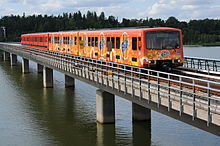
Public transport in Helsinki consists of bus, tram, metro, local railway and ferry services. The system is managed by the Helsinki Regional Transport Authority (Finnish: Helsingin seudun liikenne, or HSL) and covers Helsinki, Espoo, Kauniainen, Vantaa and the outlying Kerava, Kirkkonummi, Sipoo and Tuusula.

Until the August 9, 2021 opening of the Tampere light rail, Helsinki was the only Finnish city to have a tram system. The city of Turku dismantled its tram system in 1972, and Finland lost the city of Vyborg to the USSR in World War II and the city subsequently withdrew its trams in 1957. In 2017, construction started on a tram line in the city of Tampere; services are scheduled to initiate in 2021.[1]
50% of commuting trips within the city limits of Helsinki are made using public transport and only 28% using a private car,[2] while 48% of the households have access to a car. For comparison, Helsinki’s public transport system has a higher ridership than any city in the U.S. except New York.[citation needed]
The Helsinki Metro, opened in 1982, was the first, and so far the only, rapid-transit metro system in all of Finland. The metro currently serves the eastern suburbs of Helsinki, some areas close to the city center, and parts of southern Espoo. For the first 16 years of its existence, the line was topologically only one straight line, but in 1998 a branch to the eastern suburb of Vuosaari was opened. The construction of the long-debated western extension of the metro system into southern parts of Espoo was approved by Espoo City Council in 2006. The eight-station first phase was opened in November 2017, and the second phase, extending metro service west to Kivenlahti, opened in December 2022.[3] Helsinki is also planning to extend the existing metro line from its eastern terminus at Mellunkylä to Östersundom, an area annexed from Sipoo by Helsinki in 2009 for the purpose of building a large new planned community.
Local trains operate on grade-separated, dedicated tracks on three rail lines that radiate out from the Helsinki Central railway station. Most routes offer rapid-transit-like service with a peak headway of 10 or 15 minutes, the last trains departing from Helsinki city center only after 1 am, or 4 am on weekend nights. A service to the Helsinki Airport began in July 2015, when the Ring Rail Line extension to the system opened. A number of the local and regional trains run further out to towns as far north as Riihimäki and Lahti and as far west as Karis on tracks shared with long-distance trains. These regional services have headways of up to one hour and often more limited operating hours.
Long-distance trains depart from the Central Railway Station and Pasila railway station to destinations across Finland. Intercity trains offer connections to major Finnish cities and international services to Saint Petersburg and Moscow in Russia.
A railway tunnel has been proposed to connect Helsinki with Tallinn, though the proposal is still in the investigation phase.
- ^ Raitiotie
- ^ Survey on perception of quality of life in 75 European cities (published by European Commission in 2009)
- ^ Kuokkanen, Venla; Palkoaho, Milla; Moilanen, Kaisu (2022-10-13). "Länsimetron jatkon liikenne alkaa jo joulukuussa". Helsingin Sanomat (in Finnish). Retrieved 2023-10-22.
